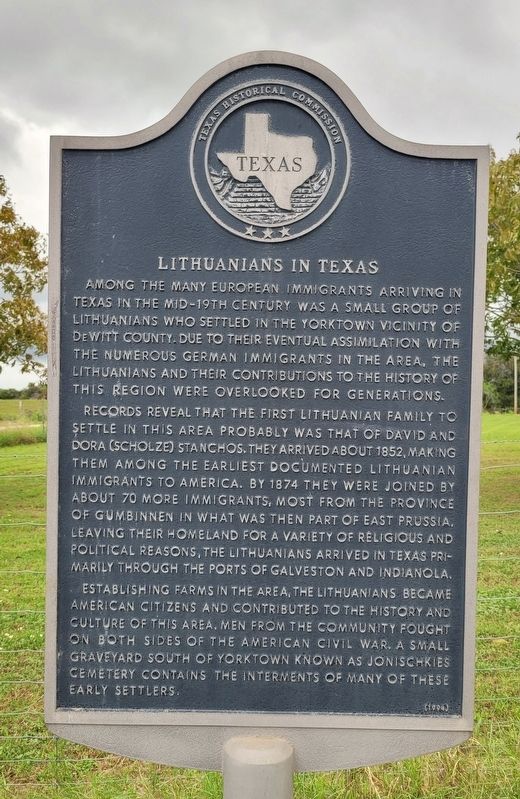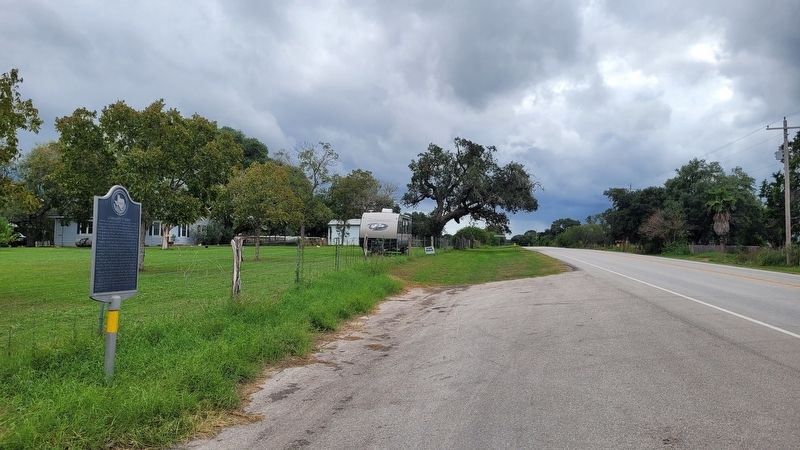Near Yorktown in DeWitt County, Texas — The American South (West South Central)
Lithuanians in Texas
Records reveal that the first Lithuanian family to settle in this area probably was that of David and Dora (Scholze) Stanchos. They arrived about 1852, making them among the earliest documented Lithuanian immigrants to America. By 1874 they were joined by about 70 more immigrants, most from the province of Gumbinnen in what was then part of East Prussia. Leaving their homeland for a variety of religious and political reasons, the Lithuanians arrived in Texas primarily through the ports of Galveston and Indianola.
Establishing farms in the area, the Lithuanians became American citizens and contributed to the history and culture of this area. Men from the community fought on both sides of the American Civil War. A small graveyard south of Yorktown known as Jonischkies Cemetery contains the interments of many of these early settlers.
Erected 1994 by Texas Historical Commission. (Marker Number 3095.)
Topics. This historical marker is listed in these topic lists: Immigration • Settlements & Settlers. A significant historical year for this entry is 1852.
Location. 28° 55.657′ N, 97° 29.962′ W. Marker is near Yorktown, Texas, in DeWitt County. Marker is at the intersection of State Highway 119 and Lee Alves Road (County Highway 3024), on the left when traveling south on State Highway 119. The marker is located along the highway. Touch for map. Marker is at or near this postal address: 3095 TX-119, Yorktown TX 78164, United States of America. Touch for directions.
Other nearby markers. At least 8 other markers are within 5 miles of this marker, measured as the crow flies. C. Eckhardt & Sons Building (approx. 3.7 miles away); Yorktown (approx. 3.7 miles away); John York and Charles Eckhardt (approx. 3.7 miles away); De Witt County (approx. 3.8 miles away); DeWitt County Veterans Memorial (approx. 3.8 miles away); Holy Cross Catholic Cemetery (approx. 3.9 miles away); Holy Cross Catholic Church (approx. 3.9 miles away); 2nd. Lt. Adolph Strieber (approx. 4˝ miles away). Touch for a list and map of all markers in Yorktown.
Also see . . . Texas Lithuanian. Global True Lithuania
Yorktown, Texas is the home to America’s oldest known Lithuanian community.(Submitted on October 26, 2023, by James Hulse of Medina, Texas.)
Most of the current Lithuanian-Texans, however, are not related to it. The population of Texas skyrocketed recently(from 9 000 000 in 1960 to 26 000 000 today) and Lithuanians were among many migrants the state attracted. Many of them are Lithuanian Americans who moved in from the north. These are, however, new trends and the massively growing Texan cities lack old Lithuanian churches, schools, or memorials.
However, it has been little known that the first Lithuanians moved into Texas in 1852, soon after the Mexican-American war. They moved in from then-German-ruled Lithuania Minor rather than the Russian-occupied and more economically backward Lithuania-proper (where serfdom still existed and migration was thus hampered). Having been raised in a German-dominated society, these Lithuanians then integrated into German-American communities (although their surnames still told of their Lithuanian origins). Together with Germans they also shared a migration goal: to find empty land lots in Texas, after a long journey by ship and then on foot into the interior.
Credits. This page was last revised on October 26, 2023. It was originally submitted on October 25, 2023, by James Hulse of Medina, Texas. This page has been viewed 117 times since then and 60 times this year. Photos: 1, 2. submitted on October 26, 2023, by James Hulse of Medina, Texas.

